
“I invite all [potential] travelers who are interested in culture to visit Iran and see that Iran is a peaceful and hospitable country,” Venezuela’s Minister of Tourism and Foreign Trade Ali Padron Paredes has said. “I am stunned by the beauties of Isfahan”, Padron Paredes added in an interview with CHTN on Thursday while touring the ancient city during his four-day visit to the Islamic Republic. The minister had toured several travel destinations and museums in Kerman before flying to Isfahan. He called his visit to Kerman as memorable. “I convey to the people and the government of Iran greetings of the people and the government of Venezuela.” “I enjoyed the journey to Iran and I want to experience this pleasure again. Iran has very hospitable and friendly people who are also friendly with the Venezuelan people,” the minister stated. Before setting off for Isfahan, Padron Paredes and his Iranian counterpart Ali-Asghar Mounesan inked a memorandum of understanding to deepen mutual tourism ties. Back in October, Mounesan exchanged views with former Venezuelan Tourism and Foreign Trade Minister Felix, Ramon Plasencia Gonzalez, in a video conference to deepen tourism relations, especially through simplifying visa rules, launching fam tours, and setting up exhibits. They also agreed to sign a memorandum of understanding in a bid to broaden bilateral ties. Last November, Mounesan said that visa-free access and direct flights are the two important advantages for Iran and Venezuela to develop tourism cooperation. The relationship between Venezuela and Iran became more serious following an official visit by the then Venezuelan President Hugo Chavez to Tehran in 2001. Isfahan, the capital of a province of the same name, is nicknamed “Nesf-e-Jahan” which is translated into “half the world”, meaning it contains fully half of the world's wonders. In its heyday, it was also one of the largest cities in the region with a population of nearly one million. The cool blue tiles of Isfahan's Islamic buildings, and the city's majestic bridges, contrast perfectly with the encircling hot, dry Iranian countryside. Big and sprawling Kerman is something of a cultural melting pot, blending various regional cultures over time. It is also home to rich tourist spots and historical sites including bazaars, mosques, caravanserais, and ruins of ancient urban areas.
Create: Feb 26, 2021 Edit: Feb 26, 2021 International News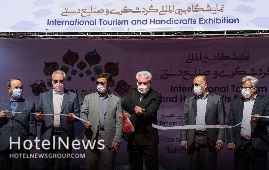
Tehran’s international tourism and handicrafts fair opened to the public on Tuesday in defiance of a government campaign to improve the hugely-battered travel sector in the face of the novel coronavirus. Cultural Heritage, Tourism, and Handicrafts Minister Ali-Asghar Mounesan and his deputies for tourism, and handicrafts were amongst attendees to the opening ceremony of the fair, which is underway at Tehran Permanent International Fairgrounds. Activists, including tour operators, hoteliers, transport businesses, and tour guides, are hopeful that such days would be numbered at the COVID-19 vaccine is getting more widespread. Since it first surfaced late in 2019, the pandemic has created a greater demand for experiences away from crowds, which is opposite to many traveling pillars. Experts say that such preference for solo travel would probably continue till a coronavirus vaccine is ever-present. “Safe and Responsible Travels” has been picked as the motto of the four-day event that according to organizers could help boost synergy among the two sectors as people have a chance to visit them maybe in a day-long visit! The event is being held according to health protocols announced by the National Headquarters for Coronavirus Control, and following the necessary coordination with the relevant agencies in this field, according to Vali Teymouri, the deputy minister for tourism. Travel agencies, airlines, sea or rail companies, entrepreneurs, startups, banks, insurance brokers, agents or hospitals in charge of health, medical tourism, sports clubs, pilgrimage & eco-tourism companies, representatives of hotels, guesthouses, touristic villages, and free zones are amongst exhibitors in the tourism sector. Furthermore, tens of booths and stands in various exhibition halls have been dedicated to craftspeople, artisans, live performers, and tribespeople who are coming together from every corner of the ancient land to promote skills inherited from generation to generation. Though its main goal of the sales exhibit is to make money and sails of the handicrafts, souvenirs, foodstuff, and various other regional products, it can be a venue for dialogue between exhibitors and visitors and even visiting officials, according to organizers. The fair showcase arrays of personal ornamentation, woodwork, illuminated manuscript, miniature, textile printing, enamel, leatherwork, handwoven textile, calligraphy, traditional musical instrument, metalwork, and marquetry among tens of others while nomadic culinary arts, live workshops, and performances that would gather own fans every corner. Iran expects to reap a bonanza from its numerous tourist spots such as bazaars, museums, mosques, bridges, bathhouses, madrasas, mausoleums, churches, towers, and mansions, of which 24 being inscribed on the UNESCO World Heritage list. Under the 2025 Tourism Vision Plan, it aims to increase the number of tourist arrivals from 4.8 million in 2014 to 20 million in 2025. So it will undeniably try its best to achieve a relatively ambitious goal but when that happens the travel industry is likely to look more altered.
Create: Feb 24, 2021 Edit: Feb 24, 2021 Regional News
Iranian tourism minister Ali-Asghar Mounesan and his deputy for handicrafts, Pouya Mahmoudian, honored some exemplary crafters and artisans on Saturday. Behruz Zarindashti in ceramic and Sara Hedayat in costume designing received Silver Cypress, during the closing ceremony of the 5th Fajr national handicrafts festival, one of Iran’s major crafts shows held in the National Museum of Iran. Furthermore, Zeinab Masudi in illumination, Abbas Jalalikia in woodwork, Saru Moqerchian in metalwork, and Vajiheh Sadat Jalali in woodcarving received honorable mentions, according to organizers. Two the recently-deceased veteran crafters; Ahmad Shishegar, who was a master of tilework, and Amir Saeim, a master of toreutics, were honored posthumously during the ceremony, which was attended by tens of artists, crafters, and cultural officials as well. Over 150 crafters practicing different fields of handicrafts participated in this edition of the festival, of which several were honored during the ceremony. This edition of the festival, which brings together works from all over the country and is a venue for showcasing tens of ancient and modern Iranian handicrafts, was held entirely online due to the coronavirus outbreak. The event showcased woodwork, illuminated manuscript, miniature, textile printing, enamel, leatherwork, calligraphy, metalwork, mirrorwork, and marquetry, among others. It also featured potteries, ceramics, personal ornamentation, rugs, and kilim carpets. With 14 entries, Iran ranks first globally for the number of cities and villages registered by the World Crafts Council, as China with seven entries, Chile with four, and India with three ones come next. In January 2020, the cities of Shiraz, Malayer, and Zanjan and the village of Qassemabad were designated by the WCC- Asia Pacific Region, putting Iran’s number of world crafts cities and villages from ten to 14. Shiraz was named a “world city of [diverse] handicrafts”. Malayer was made a global hub for woodcarving and carved-wood furniture. Zanjan gained the title of a “world city of filigree”. And Qassemabad village, which is nationally known for its traditional costumes, was also promoted to a world hub of handicrafts. Chador Shab, a kind of homemade outer-garment for women, was, however, the main subject for the WCC assessment for the village. Iran exported $523 million worth of handicrafts during the calendar year 1398 (ended March 19, 2020). Of the figure, some $273 million worth of handicrafts were exported officially through customs, and about $250 million was earned via suitcase trade (allowed for customs-free and tax-free transfer) through various provinces, according to data provided by the Ministry of Cultural Heritage, Tourism and Handicrafts. Ceramics, pottery vessels, handwoven cloths as well as personal ornamentations with precious and semi-precious gemstones are traditionally exported to Iraq, Afghanistan, Germany, the U.S., the UK, and other countries.
Create: Feb 22, 2021 Edit: Feb 22, 2021 Regional News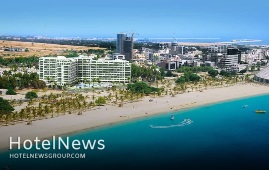
The country’s largest beach park is planned to be established in the Persian Gulf island of Kish, southern Iran. Hundreds of hectares of coastal lands on Kish Island have been ratified to be turned into a beach park, which would be the largest of its kind in the country, the CEO of Kish Civil, Water, and Urban Services Abolfazl Tayyebi said on Saturday. One of [public] benefits from the implementation of this project is that some 388,000 square meters of valuable beaches will not be ceded to the private sector, the official added. In many cities and countries of the world, nowadays, most of the beaches are owned by individuals and the private sector, and due to construction near the sea, they are out of reach of people and tourists, the official explained. With such a project and establishing facilities for the public on the island’s coastline, no one could encroach on this precious treasure that belongs to all Iranians, he noted. Amongst the Persian Gulf islands, Kish is the more luxurious and developed. Except for its unique nature such as waters and shallow beaches, the tourist attractions of this charming island are due to its rich historical background as well as kind and hospitable people. About one million foreign and domestic tourists travel to the island every year and it is one of the most popular tourist destinations in Iran as it has magnificent attractions such as Kariz Underground City, Harireh Ancient City, Greek Ship, and Grand Recreational Pier to name a few.
Create: Feb 21, 2021 Edit: Feb 21, 2021 Regional News
Iran’s southeastern Sistan-Baluchestan province has lost 1,440 billion rials ($34.2 million at the official exchange rate of 42,000 rials per dollar) in earnings from tourism as many potential visitors stay away due to the impact of the coronavirus, according to Alireza Jalalzaei, the provincial tourism chief. “Sistan-Baluchestan is a four-season travel destination and even though the province holds vast tourism capacities, it has taken some 1,440 billion rials hit from the coronavirus outbreak from mid-Esfand 1398 (early March 2020) to the end of the month Dey (January 19),” the official said on Wednesday. The official noted that Sistan-Baluchestan has set sights on [a significant] tourism development, and its travel infrastructure has been drastically extended over the past couple of years. “From the year 1396 (2017) onwards, the number of travel infrastructure in Sistan-Baluchestan has raised from 40 to 200 ones…. Nowadays tourism of this province has come to fame and distinction,” he explained. Elsewhere in his remarks, the official pointed to various tourism campaigns being launched over the past couple of years, adding the campaign ‘Let’s see Sistan, let’s hear Baluchestan’ has taken a noticeable impact on the tourism thrive of the province mainly by the means of on-line programs. “Despite all the bottlenecks, the province’s tourism has not been forced to shut….” “For instance, the occupancy rate of hotels in [the city of Chabahar] is [currently] more than 90 percent….. and currently, some 100 to 110 ecolodge unites are active across the province,” the official said. Last year, Cultural Heritage, Tourism, and Handicrafts Minister Ali-Asghar Mounesan said that the development of the travel industry across Sistan-Baluchestan province is among the top priorities for the ministry. “I am interested in Sistan-Baluchestan, and the development of this province is a priority for this ministry and the government,” the minister stated. “The majority of my travels during my tenure has been to Sistan-Baluchestan, which I consider it as a safe province with significant values in terms of culture, history, handicrafts, and tourism.” The collective province -- Sistan in the north and Baluchestan in the south -- accounts for one of the driest regions of Iran with a slight increase in rainfall from east to west, and an obvious rise in humidity in the coastal regions. In ancient times, the region was a crossword of the Indus Valley and the Babylonian civilizations. The province possesses special significance because of being located in a strategic and transit location, especially Chabahar which is the only ocean port in Iran and the best and easiest access route of the middle Asian countries to free waters. The vast province is home to several distinctive archaeological sites and natural attractions, including two UNESCO World Heritage sites, namely Shahr-e-Soukhteh (Burnt City) and Lut desert.
Create: Feb 6, 2021 Edit: Feb 6, 2021 Regional News
Iran seeks to register ancient Siraf port and several other southern seaports on the UNESCO World Heritage list in near future, Cultural Heritage, Tourism and Handicrafts Minister Ali-Asghar Mounesan has said. “We are developing a dossier [to be submitted to UNESCO] for the global registration of Siraf and several other important ports, [which are dotted across Bushehr province] in the southern coastal strip of the country,” Mounesan said on Tuesday. “The noble people of Bushehr should be waiting for the registration news,” Mounesan noted. He made the remarks during his visit to Bushehr, which is one of the most significant historical regions along the Persian Gulf, embracing significant monuments from the Elamite, Achaemenid, Parthian, and Sassanid eras. The historical port of Siraf was the most important Iranian port from the Sassanid period to the 4th century AH. It bears plentiful evidence of Persian mastership and genius in seafaring, international relations, and interaction with other near and far cultures and civilizations. Between 1966 and 1973, the British Institute of Persian Studies conducted seven seasons of excavation and survey at Siraf, which was a major city on the Iranian shore of the Persian Gulf that played a leading role in the network of maritime trade that supplied Western Asia with the products of India, the Far East, and Eastern Africa between 800 CE and 1050. Siraf had a population of about 300,000 during the early Islamic era and this fact shows that it was a large city. However, today, just about 7,000 people live in Siraf in a small area. The historical and architectural monuments of Bushehr include Islamic buildings like mosques and praying centers, mansions, old towers, castles, as well as gardens. Bushehr province is also home to various archaeological mounds including Tall-e Khandaq with Sassanid architectural style, Tall-e Marv located near an Achaemenid Palace, and Qajar era Malek al-Tojar Mansion. Traveling to the Persian Gulf region would be an experience that you probably haven’t even considered. While you’ve been planning your Iranian sojourn around the jewels of the country’s rich history (Isfahan, Shiraz, Yazd), to the southeast the Persian Gulf is equally deserving. Explore the magnetic islands of Kish, Qeshm, and Hormuz, which are absurdly easy to combine and are altogether different. While Kish is unashamedly glam and glitzy, Qeshm and Hormoz are refreshingly void of large-scale development and offer a chance to glimpse a more traditional way of life – not to mention an array of geological wonders. Along the coast, soak up the vibes of lively Bandar Abbas and make a beeline for the delightful town of Kong, whose historical center is peppered with charming old houses and monuments.
Create: Feb 5, 2021 Edit: Feb 6, 2021 Regional News
A total of eight tourism-related projects, worth three trillion rials (about $71.4 million at the official exchange rate of 42,000 rials per dollar) are scheduled to come on stream in southwestern Bushehr province. President Hassan Rouhani, and Cultural Heritage, Tourism, and Handicrafts Minister Ali-Asghar Mounesan are scheduled to inaugurate the projects via a video conference by the end of this week, the provincial tourism chief has announced. The projects will help create 275 job opportunities for the locals directly. Moreover, they will be adding 400 rooms and 1088 beds to the hospitality sector of the province, Mohammad-Hossein Arastuzadeh said on Sunday. Last April, the official announced that the tourism sector of the province is ready to jumpstart after the coronavirus crisis ends. He also stressed that the province needs innovative plans and programs to attract more tourists and travelers to its tourist attractions and historical sites. With over 6,000 years of history and significant monuments from the Elamite, Achaemenid, Parthian, and Sassanid eras, Bushehr Province is one of Iran’s most important historical centers. Besides its cultural heritage, beautiful beaches and lush palm groves make it an attractive destination for world travelers. The historical and architectural monuments of Bushehr include Islamic buildings like mosques and praying centers, mansions, old towers, castles, as well as gardens. When it comes to cultural attractions, there are many historical mounds in Bushehr including Tall-e Khandaq with Sassanid architectural style, Tall-e Marv located near an Achaemenid Palace, and Qajar era Malek al-Tojar Mansion. Qajar era Kazeruni Mansion, which has been inscribed on the World Heritage List, is another attraction that world travelers love to see among various ancient
Create: Feb 3, 2021 Edit: Feb 3, 2021 Regional News
The cultural heritage and tourism directorate of Iran’s Zanjan province is set to launch a photography contest on the UNESCO-registered Dome of Soltaniyeh and its surrounding historical and touristic sites. Competitors are requested to post works to the Instagram account of the directorate from January 31 to February 9, provincial tourism chief Amir Arjmand announced on Tuesday. A panel of professional media photographers will be judging the contest, and winners will be honored with exquisite prizes, the official said. “This competition is to be held to highlight the importance of preserving natural and cultural heritage, monuments, antiquities, museums that exist in [the city of] Soltaniyeh,” he said. The UNESCO-listed Mausoleum of Oljaytu, which is commonly known as “Dome of Soltaniyeh” (Soltaniyeh Cupola), is one of Iran’s must-visit destinations for those interested in traditional Persian and genuine Islamic architecture. The mausoleum is surmounted by one of the largest brick domes in the globe, though some mistakenly refer to it as “the largest dome in the world”. Meaning “Town of the Sultans”, Soltaniyeh was briefly the capital of Persia’s Ilkhanid dynasty (a branch of the Mongol dynasty) during the 14th century. According to UNESCO, the Mausoleum of Oljaytu is an essential link and key monument in the development of Islamic architecture in central and western Asia. Here, the Ilkhanids further developed ideas that had been advanced during the classical Seljuk phase (11th to early 13th centuries), during which the arts of Iran gained distinction in the Islamic world, thereby setting the stage for the Timurid period (late 14th to 15th centuries), one of the most brilliant periods in Islamic art. UNESCO says, “Excavations carried out in the 790-ha Mausoleum of Oljaytu property have revealed additional vestiges of the old city, and a large part of this property has retained its archaeological character. As the ancient capital of the Ilkhanid dynasty, Soltaniyeh represents an exceptional testimony to the history of the 13th and 14th centuries in Iran.” The very large dome is the earliest extant example of its type and became an important reference for the later development of the Islamic dome. Similarly, the extremely rich interior of the mausoleum, which includes glazed tiles, brickwork, marquetry, or designs in inlaid materials, stucco, and frescoes, illustrates an important movement towards more elaborate materials and themes.
Create: Jan 30, 2021 Edit: Jan 30, 2021 Regional News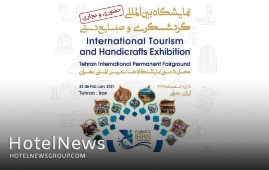
Tehran will be playing host to an international tourism and handicrafts exhibition next month. The event is scheduled to be held on both virtual and physical basis at Tehran Permanent International Fairgrounds from February 23 to 26, the deputy tourism minister Vali Teymouri announced on Wednesday, CHTN reported. The event will be held according to health protocols announced by the National Headquarters for Coronavirus Control, and following the necessary coordination with the relevant agencies in this field, Teymouri said. Optimistic forecasts, however, expect Iran to achieve a tourism boom after coronavirus contained, believing its impact would be temporary and short-lived for a country that ranked the third fastest-growing tourism destination in 2019. The latest available data show eight million tourists visited the Islamic Republic during the first ten months of the past Iranian calendar year (started March 21, 2019). . Iran welcomed some 7.8 million foreign nationals a year earlier, achieving a 52.5 percent increase year on year. Iran expects to reap a bonanza from its numerous tourist spots such as bazaars, museums, mosques, bridges, bathhouses, madrasas, mausoleums, churches, towers, and mansions, of which 24 being inscribed on the UNESCO World Heritage list. Rooted in ancient Persian civilization, the nation that has survived numerous alien invasions and natural disasters over its rich history while maintaining its appeal to local and foreign tourists.
Create: Jan 28, 2021 Edit: Jan 28, 2021 Regional News
A total of five tourism-related projects are scheduled to be inaugurated in southwestern Bushehr province, the deputy provincial tourism chief has said. Two hotels, a tourist complex, an eco-lodge unit, and a traditional restaurant will come on stream by the end of the current Iranian month of Bahman (February 18), Sakineh Salari said on Monday. A budget of 2.1 trillion rials ($50.5 million at the official exchange rate of 42,000 rials per dollar) has been allocated to the projects, which will generate over 127 job opportunities for the locals, she noted.She also noted that as the province enjoys several natural and historical attractions, establishing such centers and providing needed services will attract more domestic and foreign tourists to the region. Last April, the provincial tourism chief Mohammad-Hossein Arastuzadeh announced that the tourism sector of the province is ready to jumpstart after the coronavirus crisis ends. He also stressed that the province needs innovative plans and programs to attract more tourists and travelers to its tourist attractions and historical sites.With over 6,000 years of history and significant monuments from the Elamite, Achaemenid, Parthian, and Sassanid eras, Bushehr Province is one of Iran’s most important historical centers.Besides its cultural heritage, beautiful beaches and lush palm groves make it an attractive destination for world travelers.The historical and architectural monuments of Bushehr include Islamic buildings like mosques and praying centers, mansions, old towers, castles, as well as gardens.When it comes to cultural attractions, there are many historical mounds in Bushehr including Tall-e Khandaq with Sassanid architectural style, Tall-e Marv located near an Achaemenid Palace, and Qajar era Malek al-Tojar Mansion. Qajar era Kazeruni Mansion, which has been inscribed on the World Heritage List, is another attraction that world travelers love to see among various ancient sites.
Create: Jan 27, 2021 Edit: Jan 27, 2021 Regional News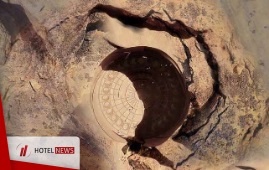
Renowned French architect Jean Novell has just unveiled the concept designs for a new hotel. This extraordinary hotel is to be turned into a cave in the deserts of Saudi Arabia. The designs are modeled on the Nabataeans, an ancient civilization in northwestern Saudi Arabia that built rock tombs near Hegra.
Create: Dec 12, 2020 Edit: Dec 12, 2020 Regional News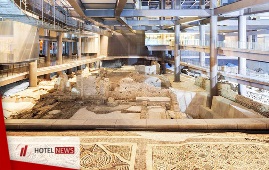
Workers were excavating in 2009 to build a hotel in Antakya, reached the remains of an important and beautiful ancient monument. The designers and investors of the hotel decided to continue the project in a bold and creative way without damaging the mosaics. This 5-storey hotel with 200 rooms hangs on metal columns and creates beautiful views.
Create: May 11, 2020 Edit: May 12, 2020 International News
